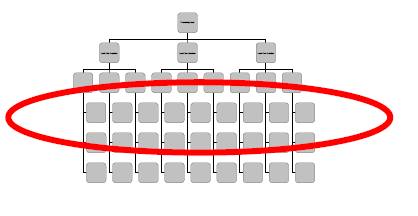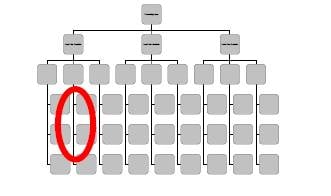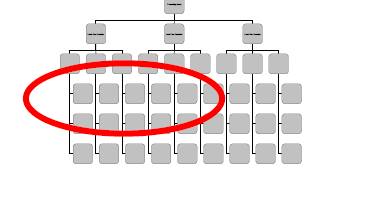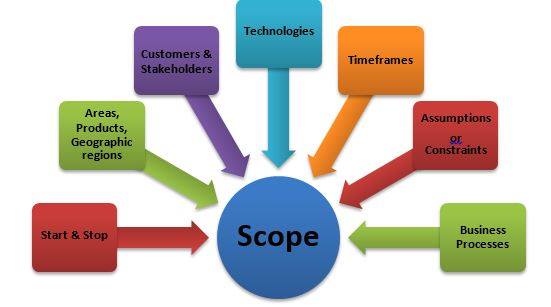Steps involved in defining Project Scope (Updated for 2019)
Did you know that project success has been linked to the project scope? Development of project scope is a very important step in project management no matter what methodology is used (traditional project management, or Lean Six Sigma). This is the first step taken by the project managers, as it clearly defines the project goals and objectives, resources required and timelines for the project.
Why is it important to define scope? On one hand, if the scope is unclear, incomplete, not finalized, or poorly developed, it can lead to the project failure. On the other hand, if the scope is clear, realistic, finalized, agreed upon and well-defined, it will contribute to the project success.
Well-Defined Scope = Project Success!
In this article, you will learn about the steps involved in defining the scope, key elements to consider in the scope statement, and how to overcome issues that may come up in the process of scope development.
First, let’s start with some basic definitions…
What is a project?
A project is an initiative, temporary in nature that has a distinct beginning and end with the goal of creating a product, service, or anticipated result. The end is reached when the objectives of the project are met, or terminated when objectives cannot or will not be able to be met. A project starts with a Planning phase, and one of the major components is the development of the project scope.
What is Scope?
The scope is simply all the work that needs to be done in order to achieve a project's objectives. In other words, the scope involves the process of identifying and documenting specific project goals, outcomes, milestones, tasks, costs, and timeline dates specific to the project objectives.
What is the right Project Scope?
When the scope is too big…
It can lose energy and focus if the project is completed, results may no longer be relevant.

When the scope is too narrow…
Can be successful, but the impact is so small that the reaction may be “so what?” or “that’s all?”.

When the scope is goal oriented…
May take 3-8 month to complete, impact contributes to a strategic goal, may create phased projects if necessary.

How to define Project Scope?
Capturing the project scope cannot be overestimated because, without a well-documented and an agreed-upon vision, the project will not achieve desired outcomes. The process of scope development requires a thorough organization and a series of steps:
-
Scope planning
-
Scope definition
-
Scope documentation
-
Scope change management
Let’s take a closer look at each step…
1. Scope planning
Determining the right project scope is the responsibility of the project manager as part of the planning phase. Some key questions to help narrow down the project scope are:
-
What does project success look like?
-
What are the factors involved in starting a project?
-
What are the project objectives and goals?
-
How is the performance going to be measured?
Once the project manager establishes these things, the next steps involve clarifying all the project aspects that are included and not included (in scope/out of scope).

-
Start and stop process steps upon which project are based.
-
Areas, Products, Geographic regions upon which the project will or will not focus.
-
Customers & Stakeholders the project is likely to impact. Identify which business functions that should be included in the scope (i.e., Human Resources, Finance, Manufacturing, Information Technology, Customer Service, etc.).
-
Information Technology Systems and existing capital infrastructure that will be used or excluded.
-
Timeframes, including expected project completion and improvements realization dates and dates when impacts will begin to be noticeable.
-
Assumption and/or Constraints on staff engagement, percentage of time working versus time dedicated to the project, budgetary requirements.
-
Business Processes that are covered in the scope or identify the business processes that will not be in the scope.
Furthermore…
2. Scope Definition

Identify Stakeholders
Stakeholders should be accounted for prior to the defining requirements. It not only helps to identify the right people for the project but also determines the best way to manage their expectations.
A project manager needs to know who is going to be involved in the project, who is close to the process, and who will have the power to make decisions. These stakeholders include project champion or sponsor, process owners, Subject Matter Experts (SMEs), managers, and day-to-day operations, staff. The project manager can utilize the stakeholder register or matrix to identify project stakeholders that can provide detailed information on the project requirements.
Collect and define requirements
This involves working with the identified project stakeholders and sponsor to understand their needs. Without knowing what the customer and users need or want, project success cannot be achieved.
The project manager may utilize tools such as interviews, focus groups, workshops, group decision making, and observations to help with the requirements gathering. It all comes together in requirement documentation as an output.
Consider Project Drivers
There are many outside influences that can affect the project. In addition to common drivers such as information technology systems, other drivers could be regulatory, law, or standards. In the current business world, security and safety are raising concerns, therefore, should be considered in the project scope definition. Each driver must be clearly identified as attention to these is important in any project.
3. Scope Documentation
Project Scope Statement
The project scope statement document provides detailed justification for the project purpose. It describes project deliverables, objectives, and what needs to be done to accomplish those deliverables.
The project scope also serves as a “source of truth” for the project scope to establish a common understanding among the stakeholders. It is also a way to maintain expectations for any exclusion or out of scope items. Most importantly, the review and approval record is documented in the document.
Another benefit of the scope statement is that it enables the project team to stay on track with planning, guides through the execution phase, and lays out a ground base for any changes or additional work that can be included (in scope) or excluded (out of scope).
Writing the Project Scope Statement
The project scope document should include all the important information about what’s included and excluded in the project. The Project Scope Statement Template can be used to help the project manager to capture scope details.
The key elements should include but not limited to:
-
Objectives
-
Deliverables
-
Milestones
-
Requirements
-
Assumptions
-
Risks
-
Review and Approval
Tips on writing the best Project Scope Statement
Tip #1: Be very specific. The more details you have, the better understanding among readers there will be. Plus, you won’t get too many questions if your statement is clear.
Tip #2: The document should be a good length, not too long but not too short. The rule of thumb is: include all the relevant information that needs to be conveyed about the project. Do not include information that doesn’t pertain to the project.
Tip #3: Identify all the risks or uncertainties that help to prepare for any situation.
Tip #4: Finally, once you gather all the information, start writing by creating a draft. Pace yourself, don’t rush as you may miss important details.
Depending on how well the project scope statement is defined and written, it will determine how well the project management team controls the overall project.
If all goes well…


Or, if not so well…
4. Scope Change Management
Project managers would agree that changes to the project always happen no matter how small or big they are, it is almost inevitable. Setting up an effective scope management control process is very important especially when it comes to issues with the project scope. It must be set up as early as possible in the scope planning phase.
Problems with Project Scope
One of the mistakes that the project managers make is poor planning in defining the project scope. Managing scope throughout the project Life Cycle will be very challenging in this case.
As a result, you can end up with higher project costs, increased project time, and low productivity. Common reasons include no project champion or sponsor support or approval, lack of project team accountability, and…
Oh, no…it is scope creep!

What is Scope Creep?
Scope creep in project management happens when additional features, functions, requirements or work are added beyond the agreed-upon scope with no consideration to impacts on time, cost and resources or stakeholders/customer approval. It is also known as feature creep, focus creep, requirement creep, or kitchen-sink syndrome – that can sneak in and destroy the project.
Beware of the scope creep, even if the project scope is clearly defined!
Why does Scope Creep occur?
Scope creep can occur in many different ways. The project team often times makes decisions to incorporate changes that seem to be small without stakeholders' knowledge or not following proper change management process. Any breakdown in scope planning steps can also create a scope creep.
Here are the top 5 reasons for which the scope creep may occur:
-
Scope definition (unclear, ambiguous, and unrefined, etc.)
-
Poor management of scope and requirements (change management wasn’t followed)
-
Inconsistent collection of project requirements (fuzzy process boundaries)
-
Stakeholders’ or sponsor engagement (lack of sponsorship or stakeholder involvement)
-
Length of a project (the longer a project, the greater the chance for scope creep)
Can you overcome Scope Creep?
Controlling scope creep can turn into an overwhelming activity, however, it is achievable. As we noted earlier, change is almost inevitable, but scope creep is not. The good news is that there are ways to prevent scope creep.
5 Tips to control scope creep:
-
Understand the project with the clearly defined scope and requirements
-
Set clear, measurable objectives
-
Establish an effective change management process and properly follow it
-
Consistently provide project updates, focus on deliverables, and engage sponsor and stakeholders
-
Break down projects into smaller sub-projects
The key to an effective project scope change management is timely communication to stakeholders of changes that have an impact on cost, schedule, and quality.
Let’s recap…
In Conclusion
The importance of project scope definition cannot be overestimated as it correlates to project success. Poor scope definition can lead to the project failure and well-defined scope will result in project success.
Project scope definition must be done early on as part of the planning phase by the project manager. Steps involved in defining the project scope include scope planning, scope definition, scope documentation, and scope change management.
In scope planning, identifying what is in scope versus out scope helps to narrow down to the right work that needs to be done. Furthermore, collecting and defining requirements, identifying all the stakeholders who need to be involved are the next steps in defining the scope.
Documenting the project scope statement becomes an important tool in project scope management. It provides project justification, describes objectives and how to accomplish them, conveys information to stakeholders for understanding and serves as a record of review and approval. Finally, creating an effective scope change management will help to overcome project scope issues such as scope creep.
So, remember…
Well-Defined Scope = Project Success!
Click here to kickstart your Project Management career
